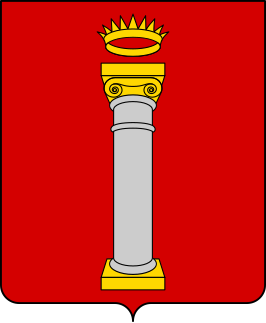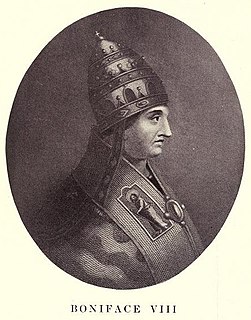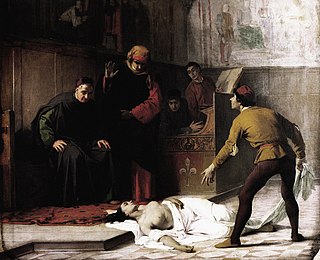
The Colonna family, also known as Sciarrillo or Sciarra, is an Italian papal noble family. It was powerful in medieval and Renaissance Rome, supplying one Pope and many other church and political leaders. The family is notable for its bitter feud with the Orsini family over influence in Rome, until it was stopped by Papal Bull in 1511. In 1571, the heads of both families married nieces of Pope Sixtus V. Thereafter, historians recorded that "no peace had been concluded between the princes of Christendom, in which they had not been included by name".

Pope Boniface VIII was pope from 24 December 1294 to his death in 1303. Caetani was of baronial origin with family connections to the papacy. He succeeded Pope Celestine V, a Benedictine, who had resigned from the papal throne. Boniface spent his early career abroad in diplomatic roles. In the College of Cardinals, he discriminated not only against the Benedictines but also members of the Colonna family, some of whom had contested the validity of the 1294 papal conclave that elected him following the unusual resignation of Pope Celestine V. The dispute resulted in battles between troops of Boniface and his adversaries and the deliberate destruction and salting of the town of Palestrina, despite the pope's assurances that the surrendering city would be spared.

Pope Clement XI, born Giovanni Francesco Albani, was head of the Catholic Church and ruler of the Papal States from 23 November 1700 to his death in 1721.

Pope Callixtus II or Callistus II, born Guy of Burgundy, was head of the Catholic Church and ruler of the Papal States from 1 February 1119 to his death in 1124. His pontificate was shaped by the Investiture Controversy, which he was able to settle through the Concordat of Worms in 1122.

Pope Innocent X, born Giovanni Battista Pamphilj, was head of the Catholic Church and ruler of the Papal States from 15 September 1644 to his death in 1655.

Pope Innocent XII, born Antonio Pignatelli, was Pope from 12 July 1691 to his death in 1700.

The Avignon Papacy, also known as the Babylonian Captivity, was the period from 1309 to 1376 during which seven successive popes resided in Avignon rather than in Rome. The situation arose from the conflict between the papacy and the French crown, culminating in the death of Pope Boniface VIII after his arrest and maltreatment by Philip IV of France. Following the further death of Pope Benedict XI, Philip forced a deadlocked conclave to elect the French Clement V as pope in 1305. Clement refused to move to Rome, and in 1309 he moved his court to the papal enclave at Avignon, where it remained for the next 67 years. This absence from Rome is sometimes referred to as the "Babylonian captivity of the Papacy".

The papal tiara is a crown that was worn by popes of the Catholic Church from as early as the 8th century to the mid-20th. It was last used by Pope Paul VI in 1963 and only at the beginning of his reign.
In the Catholic Church, a jubilee is a special year of remission of sins and universal pardon. In Leviticus, a jubilee year is mentioned to occur every 50th year, during which slaves and prisoners would be freed, debts would be forgiven and the mercies of God would be particularly manifest.
Papal coats of arms are the personal coat of arms of popes of the Catholic Church. These have been a tradition since the Late Middle Ages, and has displayed his own, initially that of his family, and thus not unique to himself alone, but in some cases composed by him with symbols referring to his past or his aspirations. This personal coat of arms coexists with that of the Holy See.

San Martino ai Monti, officially known as Santi Silvestro e Martino ai Monti("SS Sylvester & Martin in the Mountains"), is a minor basilica in Rome, Italy, in the Rione Monti neighbourhood. It is located near the edge of the Parco del Colle Oppio, near the corner of Via Equizia and Viale del Monte Oppio, about five to six blocks south of Santa Maria Maggiore.

A cardinal-nephew was a cardinal elevated by a pope who was that cardinal's relative. The practice of creating cardinal-nephews originated in the Middle Ages, and reached its apex during the 16th and 17th centuries. The last cardinal-nephew was named in 1689 and the practice was extinguished in 1692. The word nepotism originally referred specifically to this practice, when it appeared in the English language about 1669. From the middle of the Avignon Papacy (1309–1377) until Pope Innocent XII's anti-nepotism bull, Romanum decet pontificem (1692), a pope without a cardinal-nephew was the exception to the rule. Every Renaissance pope who created cardinals appointed a relative to the College of Cardinals, and the nephew was the most common choice, although one of Alexander VI's creations was his own son.
Gerardo Bianchi was an Italian churchman and papal diplomat, an important figure of the War of the Sicilian Vespers.

Jean Lemoine, Jean Le Moine, Johannes Monachus was a French canon lawyer, Cardinal, bishop of Arras and papal legate. He served Boniface VIII as representative to Philip IV of France, and founded the Collège du Cardinal Le Moine, in Paris. He is the first one to formulate the legal principle of the presumption of innocence.

The Captain General of the Church was the de facto commander-in-chief of the papal armed forces during the Middle Ages. The post was usually conferred on an Italian or other noble with a professional military reputation or (later) a relative of the pope. The parallel office of Gonfalonier of the Church was more a formal and ceremonial honor than the responsibility of a tactical military leader. The office was at times made subordinate to temporary offices, Pope Callixtus III appointed Cardinal Rodrigo Borgia to the office "Chief and General Commissary of the Papal Army." A number of such offices under many titles were used as ministers of war by popes, the captain general operated as a field commander under these offices. Pope Innocent XII removed both ranks and replaced them with the position of Flag-bearer of the Holy Roman Church, which later became hereditary in the Naro Patrizi.

The papal conclave of 1294 was convoked in Naples after the resignation of Pope Celestine V on 13 December 1294. Celestine V had only months earlier restored the election procedures set forth in the papal bull Ubi periculum of Pope Gregory X, which had been suspended by Pope Adrian V in July 1276. Every papal election since then has been a papal conclave. It was the first papal conclave held during the lifetime of the preceding pontiff, an event not repeated until the papal conclave of 2013 following the resignation of Pope Benedict XVI.

The Gonfalonier was the holder of a highly prestigious communal office in medieval and Renaissance Italy, notably in Florence and the Papal States. The name derives from gonfalone, the term used for the banners of such communes.

The papal conclave of 1303 elected Pope Benedict XI to succeed Pope Boniface VIII.

The Gonfalonier of the Church or Papal Gonfalonier was a military and political office of the Papal States. Originating from the use of the Papal banner during combat, the office later became largely ceremonial and political. At his nomination, the Gonfalonier was given two banners, one with the arms of the Church and another with the arms of the reigning pope. The Gonfalonier was entitled to include ecclesiastical emblems upon his own arms, usually only during his term of office but on occasion permanently. Pope Innocent XII ended the rank, along with the captaincy general, and replaced them both with the position of Flag-bearer of the Holy Roman Church, which later became hereditary in the Naro Patrizi.
Pedro Rodríguez de Quexada or Petrus Hispanus was an ecclesiastic from Castile.

















